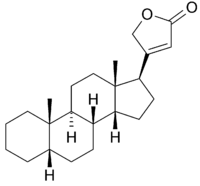Cardenolide
 | |
| Identifiers | |
|---|---|
| ChemSpider | 19954501 |
| |
| Jmol-3D images | Image Image |
| PubChem | 3035019 |
| |
| Properties | |
| C23H34O2 | |
| Molar mass | 342.51486 |
| Except where noted otherwise, data is given for materials in their standard state (at 25 °C (77 °F), 100 kPa) | |
| | |
| Infobox references | |
Cardenolide is a type of steroid. Many plants contain derivatives, collectively known as cardenolides, including many in the form of cardenolide glycosides (cardenolides that contain structural groups derived from sugars). Cardenolide glycosides are often toxic; specifically, they are heart-arresting.
Etymology
Supposedly, the term derives from Greek καρδία kardiā, "heart" and the suffix -enolide. It should not be confused with cardanolides. Cardanolides are a class of steroids (or aglycones if viewed as cardiac glycoside constituents), and cardenolides are a subtype of this class (see MeSH D codes list).
Structure
Cardenolides are C(23)-steroids with methyl groups at C-10 and C-13 and a five-membered lactone (specifically a butenolide) at C-17. They are aglycone constituents of cardiac glycosides and must have at least one double bond in the molecule. The class includes cardadienolides and cardatrienolides. Members include:
- acetyldigitoxins
- acetyldigoxins
- cymarine
- digitoxin
- digitoxigenin
- digoxigenin
- digoxin
- medigoxin
- neoconvalloside
- ouabain
- strophanthins
- strophanthidin
Marinobufagenin is similar in structure and function.
As defense mechanism
Some plant and animal species use cardenolides as defense mechanisms, notably the milkweed butterflies.[1] Species such as the Monarch and the Queen the cardenolides contained in the milkweeds (Asclepias) that they mostly feed on as larvae. The cardenolide content in butterflies deters most vertebrate predators, except a few which have evolved to become cardenolide-tolerant, such as the Black-backed Orioles (Icterus abeillei Lesson) andBlack-headed Grosbeaks (Pheucticus melanocephalus Swainson) that account for 60% of monarch butterfly mortalities in the overwintering sites in central Mexico. In addition to milkweeds and other members of the Apocynaceae, plants in at least 12 botanical families have convergently evolved cardenolides.[2]
References
- "Interactions with Milkweed". Monarch Lab. University of Minnesota. Retrieved 2014-03-25.
| ||||||||||||||||||||||||||||||||||||||||||||||||||||